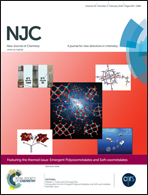A highly selective and biocompatible chemosensor for sensitive detection of zinc(ii)†
Abstract
2-Formyl-4-methyl-6-(2-benzoimidazolyliminomethyl)phenol (HL1) has been synthesized via Schiff-base condensation between 4-methyl-2,6-diformylphenol and 2-aminobenzimidazole in a 1 : 1 ratio in acetonitrile and characterized using elemental analysis and different spectroscopic methods. HL1 has been found to be a selective fluorescence sensor for Zn2+ ions. The emission intensity of HL1 at 528 nm in 10 mM HEPES buffer in water : methanol (1 : 9, v/v) (pH = 7.2) increases in the presence of Zn2+ when it is excited at 445 nm. Other metal ions can induce a slight increment or lowering of emission intensity. The spectral properties of HL1 and 2-formyl-4-methyl-6-(2-benzoimidazolylmethyliminomethyl)phenol (HL2) have been compared. It has been found that the presence of the methylene group in HL2 can have a significant effect on the absorption and fluorescence peak positions of the Schiff-base molecule and its zinc complex. Some theoretical calculations have been done to get a better view into the different spectral transitions. HL1 and HL2 have been found to be highly sensitive towards the detection of Zn2+ ions with very low LOD values. Excitation in the visible region and the effect of pH on the emission intensity of HL1 encourage us to carry out biological studies. HL1 has been used for human lung cancer cell (A549) imaging without cytotoxicity.


 Please wait while we load your content...
Please wait while we load your content...